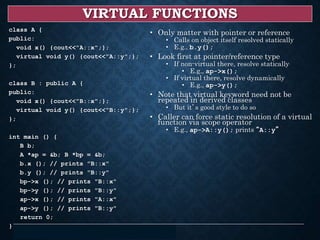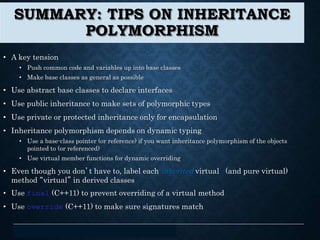This document provides an overview of polymorphism in C++. It discusses the different forms of inheritance like public, protected, and private inheritance. It explains key concepts like static and dynamic typing, virtual functions, and how they enable runtime polymorphism. Abstract base classes with pure virtual functions allow defining interfaces without implementing details. Proper use of inheritance polymorphism involves pushing common code up into base classes while allowing subclasses to override virtual functions dynamically based on the runtime type.
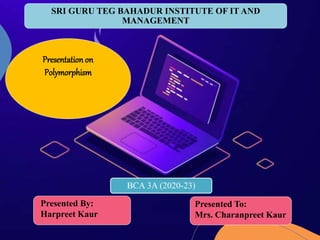
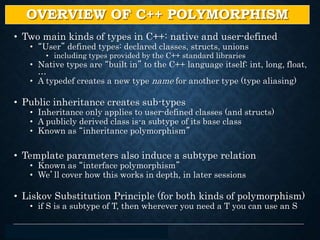
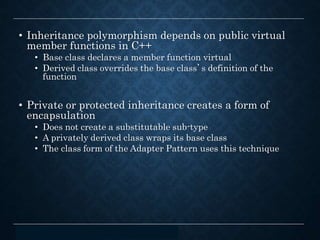
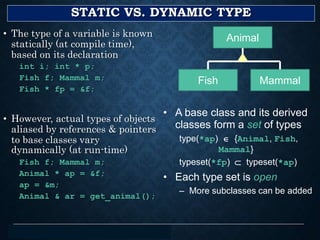
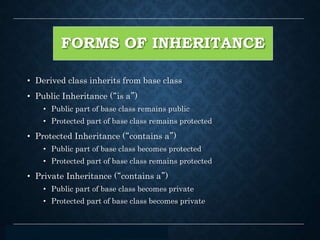
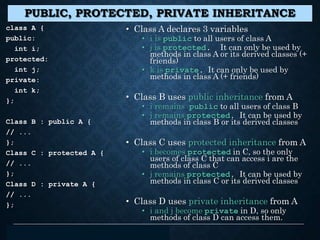
![CSE 332: C++ Polymorphism
CLASS AND MEMBER CONSTRUCTION ORDER
class A {
public:
A(int i) :m_i(i) {
cout << "A“ << endl;}
~A() {cout<<"~A"<<endl;}
private:
int m_i;
};
class B : public A {
public:
B(int i, int j)
: A(i), m_j(j) {
cout << “B” << endl;}
~B() {cout << “~B” << endl;}
private:
int m_j;
};
int main (int, char *[]) {
B b(2,3);
return 0;
};
• In the main function, the B constructor
is called on object b
• Passes in integer values 2 and 3
• B constructor calls A constructor
• passes value 2 to A constructor via
base/member initialization list
• A constructor initializes m_i
• with the passed value 2
• Body of A constructor runs
• Outputs “A”
• B constructor initializes m_j
• with passed value 3
• Body of B constructor runs
• outputs “B”](https://image.slidesharecdn.com/presentationonpolymorphismsds-220923074145-bb744c59/85/Presentation-on-Polymorphism-SDS-ppt-7-320.jpg)
![CSE 332: C++ Polymorphism
CLASS AND MEMBER DESTRUCTION ORDER
class A {
public:
A(int i) :m_i(i) {
cout << "A“ << endl;}
~A() {cout<<"~A"<<endl;}
private:
int m_i;
};
class B : public A {
public:
B(int i, int j) :A(i), m_j(j) {
cout << “B” << endl;}
~B() {cout << “~B” << endl;}
private:
int m_j;
};
int main (int, char *[]) {
B b(2,3);
return 0;
};
• B destructor called on object b in main
• Body of B destructor runs
• outputs “~B”
• B destructor calls “destructor” of m_j
• int is a built-in type, so it’s a no-op
• B destructor calls A destructor
• Body of A destructor runs
• outputs “~A”
• A destructor calls “destructor” of m_i
• again a no-op
• Compare orders of construction and
destruction of base, members, body
• at the level of each class, order of steps is
reversed in constructor vs. destructor
• ctor: base class, members, body
• dtor: body, members, base class](https://image.slidesharecdn.com/presentationonpolymorphismsds-220923074145-bb744c59/85/Presentation-on-Polymorphism-SDS-ppt-8-320.jpg)
![CSE 332: C++ Polymorphism
VIRTUAL FUNCTIONS
class A {
public:
A () {cout<<" A";}
virtual ~A () {cout<<" ~A";}
virtual f(int);
};
class B : public A {
public:
B () :A() {cout<<" B";}
virtual ~B() {cout<<" ~B";}
virtual f(int) override; //C++11
};
int main (int, char *[]) {
// prints "A B"
A *ap = new B;
// prints "~B ~A" : would only
// print "~A" if non-virtual
delete ap;
return 0;
};
• Used to support polymorphism with
pointers and references
• Declared virtual in a base class
• Can override in derived class
• Overriding only happens when signatures
are the same
• Otherwise it just overloads the function or
operator name
• More about overloading next lecture
• Ensures derived class function definition
is resolved dynamically
• E.g., that destructors farther down the
hierarchy get called
• Use final (C++11) to prevent overriding
of a virtual method
• Use override (C++11) in derived class to
ensure that the signatures match (error if
not)](https://image.slidesharecdn.com/presentationonpolymorphismsds-220923074145-bb744c59/85/Presentation-on-Polymorphism-SDS-ppt-9-320.jpg)
